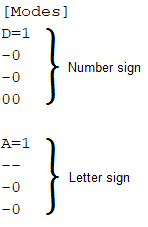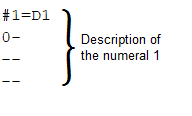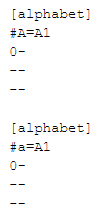
Designing Braille code consists in the definition, through dots, of how Braille characters are visualized.
Each EngView installation comes with one Braille code file, EBU Pharmaceutical.txt, located in C:\EngViewWork7\Settings\Braille\Alphabets.
Braille code file is structured in three sections:
Descriptions of the three sections follow.
The program uses two parameters to set the number of columns and rows in a character cell:
The parameters are defined at the top of the Braille code file, in the [Params] section.
The following example describes a character cell with two columns and three rows:

The program uses two modes to distinguish between Braille numerals and letters:
In the Braille code file, the character modes section comes after the [Params] section, in the [Modes] section.
The following example describes the structure of numerals (indicated by the letter D) and letters (indicated by the letter A):

In the Braille code file, the alphabet section comes after the [Modes] section, in the [alphabet] section.
A Braille code characters are described individually after the following pattern:

The following example describes the structure of:
| Letter | Numeral | Symbol |
 |
 |
 |
See an example for the structure of lowercase letter a and uppercase letters A:

NOTE: The EBU Pharmaceutical alphabet, which is part of your installation, contains descriptions of lowercase letters only. This requires you to type only lowercase when you are entering Braille text. You can create your own alphabet and set in it the symbols that you want to use.